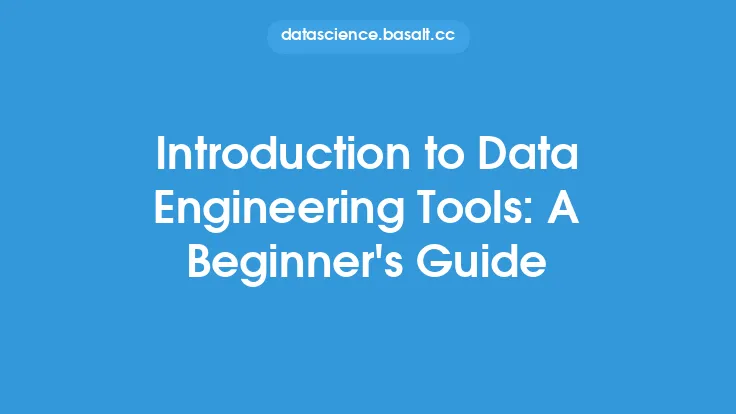The world of data engineering is rapidly evolving, with new tools and technologies emerging every day. As a data engineer, it's essential to stay up-to-date with the latest developments and leverage the right tools to streamline your data workflow. In this article, we'll delve into the world of data engineering tools and explore how they can help you optimize your data processing, storage, and analysis.
What are Data Engineering Tools?
Data engineering tools are software applications designed to help data engineers build, manage, and maintain large-scale data systems. These tools enable data engineers to design, implement, and operate data pipelines, architectures, and infrastructure, ensuring that data is properly collected, processed, and delivered to the right stakeholders. Data engineering tools can be categorized into several types, including data integration tools, data storage tools, data processing tools, and data governance tools.
Benefits of Using Data Engineering Tools
Using data engineering tools can bring numerous benefits to an organization. Some of the most significant advantages include:
- Improved data quality: Data engineering tools can help ensure that data is accurate, complete, and consistent, reducing errors and inconsistencies.
- Increased efficiency: Automated data processing and workflows can save time and reduce manual labor, enabling data engineers to focus on higher-value tasks.
- Scalability: Data engineering tools can handle large volumes of data, making it easier to scale data systems and support growing business needs.
- Faster time-to-insight: By streamlining data workflows, data engineering tools can help organizations get insights and value from their data faster.
- Better collaboration: Data engineering tools can facilitate collaboration among data engineers, data scientists, and other stakeholders, ensuring that everyone is working with the same data and towards the same goals.
Types of Data Engineering Tools
There are many types of data engineering tools available, each designed to address specific needs and challenges. Some of the most common types of data engineering tools include:
- Data integration tools: These tools enable data engineers to connect to various data sources, extract data, and load it into a target system. Examples include Apache NiFi, Apache Beam, and AWS Glue.
- Data storage tools: These tools provide a repository for storing and managing large volumes of data. Examples include relational databases (e.g., MySQL), NoSQL databases (e.g., MongoDB), and data warehouses (e.g., Amazon Redshift).
- Data processing tools: These tools enable data engineers to process and transform data in real-time or batch mode. Examples include Apache Spark, Apache Flink, and Google Cloud Dataflow.
- Data governance tools: These tools help data engineers manage data quality, security, and compliance. Examples include data catalog tools (e.g., Apache Atlas), data lineage tools (e.g., Apache Zeppelin), and data security tools (e.g., Apache Knox).
How to Choose the Right Data Engineering Tools
With so many data engineering tools available, choosing the right ones can be overwhelming. To make the right choice, consider the following factors:
- Business requirements: Identify the specific needs and challenges of your organization, and look for tools that address those needs.
- Data volume and complexity: Choose tools that can handle the volume and complexity of your data.
- Scalability and performance: Select tools that can scale with your growing business needs and provide high performance.
- Integration and compatibility: Ensure that the tools you choose can integrate with your existing data systems and infrastructure.
- Cost and licensing: Consider the total cost of ownership, including licensing fees, support costs, and training expenses.
Best Practices for Implementing Data Engineering Tools
Implementing data engineering tools requires careful planning, execution, and maintenance. Here are some best practices to keep in mind:
- Develop a clear data strategy: Define your data goals, objectives, and requirements before selecting and implementing data engineering tools.
- Design a scalable architecture: Build a data architecture that can scale with your growing business needs.
- Implement automated workflows: Use data engineering tools to automate data processing, storage, and analysis workflows.
- Monitor and optimize performance: Continuously monitor and optimize the performance of your data engineering tools and workflows.
- Provide training and support: Ensure that data engineers and other stakeholders have the necessary training and support to use data engineering tools effectively.
Future of Data Engineering Tools
The future of data engineering tools is exciting and rapidly evolving. Some of the trends and innovations to watch include:
- Cloud-native data engineering: The increasing adoption of cloud-native technologies and platforms is changing the way data engineers design, build, and manage data systems.
- Artificial intelligence and machine learning: The integration of AI and ML into data engineering tools is enabling new levels of automation, optimization, and insight.
- Real-time data processing: The growing demand for real-time data processing and analytics is driving the development of new tools and technologies.
- Data governance and security: The increasing importance of data governance and security is leading to the development of new tools and technologies that can help organizations manage and protect their data.
Conclusion
Data engineering tools are essential for building, managing, and maintaining large-scale data systems. By understanding the different types of data engineering tools, their benefits, and how to choose and implement them, data engineers can streamline their data workflows, improve data quality, and increase efficiency. As the field of data engineering continues to evolve, it's essential to stay up-to-date with the latest trends, innovations, and best practices to ensure that your organization is getting the most value from its data.





